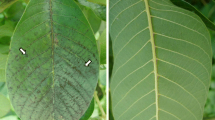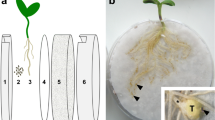Abstract
Changes of epidermal cells in the haustorium of the parasiticCuscuta japonica during its attachment to the host plantimpatiens balsamina were studied with light and electron microscopy. In the transverse sections of dodder stems not in contact with the host, epidermal cells had rounded outlines. However, when haustorial initials developed in the cortex of the parasite stem at the contact site, the epidermal cells had more dense cytoplasm and conspicuous nuclei than before, and their outline was flat in the longitudinal section. As meristem cells developed from those initials, the epidermal cells became more elongated. When the haustorium was fully matured, the apical tips of the elongated epidermal cells at the contact site branched like toes, producing numerous projections via cell wall invaginations. This event caused spaces to form between the projections; coincidently, the surface area of the apical ends of the epidermal cells increased. The dense cytoplasm at those projections contained prominent nuclei and abundant other organelles, suggesting a active metabolism. Osmiophilic particles, releasing into the cell walls from the cytoplasm, were though to be associated with the loosening and elongating of the epidermal cell walls. Dense and homogeneous materials were secreted within the spaces between the projections. These materials could play an important role in cementing the haustorium onto the surface of the host organ.
Similar content being viewed by others
Literature Cited
Baird WV, Riopel JL (1983) Experimental studies of the attachment of the parasitic angiospermAgalinis purpurea to a host. Protoplasma 118; 206–218
Dawson JH, Musselman LJ, Wolswinkel P, Dörr I(1994) Biology and control ofCuscuta. Rev Weed Sci 6: 265–317
Edelmann HG, Sievers A (1995) Unequal distribution of osmiophilic particles in the epidermal periplasmic space of upper and lower flanks of gravi-responding rye coleoptiles. Planta 196:396–399
Edelmann HG, Volkmann D (1996) The effect of brefeldin A on the redistribution of osmiophilic particles and the gravitropic response of rye coleoptiles. Protoplasma 190: 1–7
Edelmann HG, Bergfeld R, Schopfer P (1995) Effect of inhibition of protein glycosylation on auxin-induced growth and the occurrence of osmiophilic particles in maize (Zea mays L.) coleoptiles. J Exp Bot 46: 1745–1752
Heide-Jørgensen HS (1987) Changes in cuticle structure during development and attachment of the upper haustorium ofCuscuta L.,Cassytha L., andViscum L.,In HC Weber, W Forstreuter, eds, Parasitic Flowering Plants. Proceedings of the 4th International Symposium of Parasitic Flowering Plants, Marburg, Federal Republic of Germany, pp 319–334
Heide-Jørgensen HS (1989) Development and ultrastructure of the haustorium ofViscum minimum. I. The adhesive disk. Can J Bot 67: 1161–1173
Heide-Jørgensen HS (1991a) Anatomy and ultrastructure of the haustorium ofCassytha pubescens R. Br, I. The adhesive disk. Bot Gaz 152: 321–334
Heide-Jørgensen HS (1991b) Notes on the structure of the adhesive disk ofCuscuta, In JK Ransom, LJ Musselman, AD Worsham, C Parker, eds, Proceedings of the 5th International Symposium of Parasitic Weeds, Nairobi, Kenya, p 513
Hoffmann-Benning S, Klomparens KL, Kende H (1994) Characterization of growth-related osmiophilic particles in corn coleoptiles and deepwater rice intemodes. Ann Bot 74: 563–572
Jeol DM, Losner-Goshen D (1994) The attachment of the parasitic angiospermOrobanche cumana and O.aegyptiaca and its development. Can J Bot 72: 564–574
Kuijt J (1969) The Biology of Parasitic Flowering Plants. University of California Press, Berkley
Kuijt J (1977) Haustoria of phanerogamic parasites. Annu Rev Phytopathol 17: 91–118
Lee KB (2006) Ultrastructure of mature embryos in the parasitic flowering plantCuscuta japonica. J Plant Biol 49: 384–391
Lee KB (2007a) Ultrastructure and development of seedlings in the parasitic weedCuscuta japonica. J Plant Biol 50: 213–219
Lee KB (2007b) Ultrastructure of crystalline inclusions in the thyla-koids of dodder (Cuscuta japonica) plastids. J Plant Biol 50: 325–330
Lee KB (2007c) Structure and development of the upper haustorium in the parasitic flowering plant Cuscutajaponica. Amer J Bot 97: 737–745
Lee KB, Lee CD (1989) The structure and development of the haustorium inCuscuta australis. Can J Bot 67: 2975–2983
Lesny M (1991)Striga asiatica chemotropism and haustoria formation in the presence of resistant and susceptible sorghum cultivars. M.S. thesis, Department of Biology, University of Virginia, USA.
Losner-Goshen D, Portnoy VH, Mayer AM, Jeol DM (1998) Pectolytic activity by the haustorium of the parasitic plantOrobanche L. (Orobancheaceae) in host root. Ann Bot 81: 319–326
Neumann U, Vian B, Weber HC, Salle G (1999) Interface between haustoria of parasitic member of the Schrophulariaceae and their hosts: A histological and immunocytochemical approach. Protoplasma 207: 84–97
Olsen P (1980) The visualization of wall-associated granules in thin sections of higher plant cells: Occurrence, distribution, morphology, and possible role in cell wall biogenesis. Z Pflanzen-physiol 96: 35–48
O’Malley RC, Lynn DG (2000) Expansin message regulation in parasitic angiosperms making time in development. Plant Cell 12: 1455–1465
Riopel JL, Timko MP (1995) Haustorial initiation and differentiation,In MC Press, JD Graves, eds, Parasitic Plants. Chapman and Hill, London, pp 39–79
Robinson DG (1995) Osmiophilic particles at the plasma membrane — What role do they play in extension growth. Bot Acta 109:81–83
Samajova O, Volkmann D, Edelmann HG (1998) Occurrence of osmiophilic particles is correlated to elongation growth of higher plants. Protoplasma 202: 185–191
Schopfer P (1990) Cytochemical identification of arabinogalactan protein in the outer epidermal wall of maize coleoptiles. Planta 183: 139–142
Spurr A (1969) A low-viscosity epoxy resin embedding medium for electron microscopy.J Ultrastruct Res 26: 31–43
Tada Y, Sugai M, Furuhashi K (1996) Haustoria of Cuscutajaponica, a parasitic flowering plant, are induced by the cooperative effects of far-red light and tactile stimuli. Plant Cell Physiol 37:1049–1053
Vaughn KC (2002) Attachment of the parasitic weed dodder to the host. Protoplasma 219: 227–237
Vaughn KC, Barger W, Cosgrove D (2001) Dodders utilize expansin to attach and invade the host. Plant Biol 2000: 17–18
Weinert G, Barckhaus RH (1975) Fortified synthesis of cutin at the contact-zones between Cuscutaodorata andPelargonium zonale. Cytobios 13: 17–21
Author information
Authors and Affiliations
Corresponding author
Rights and permissions
About this article
Cite this article
Lee, K.B. Anatomy and ultrastructure of epidermal cells in the haustorium of a parasitic flowering plant,Cuscuta japonica, during attachment to the host. J. Plant Biol. 51, 366–372 (2008). https://doi.org/10.1007/BF03036140
Received:
Accepted:
Issue Date:
DOI: https://doi.org/10.1007/BF03036140




